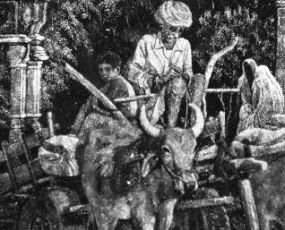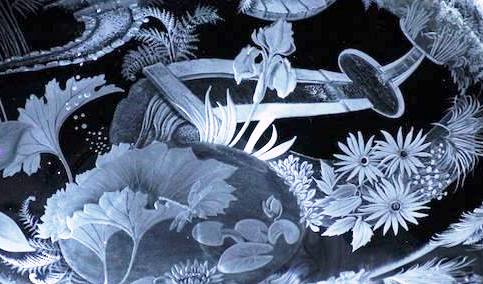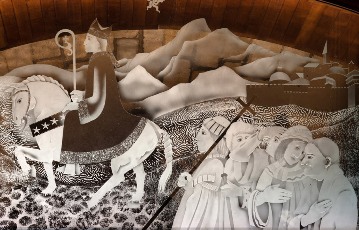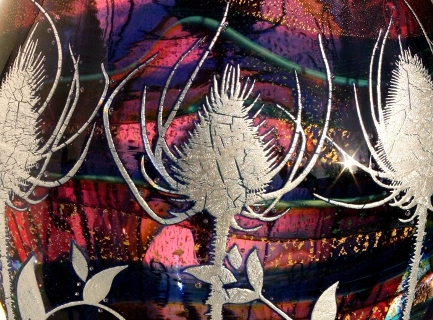What is glass engraving?
'My own analogy of glass is to imagine that it is actually made of light; light trapped between two polished skins. Scratch the surface and light is released at that place. The engraver's task is to find and release the light in the way that best expresses his ideas'.
Simon Whistler On a Glass Lightly, 2005
|
At its simplest, engraving involves using a tool to abrade the surface of the glass in order to leave a mark. There are many ways to do this, and many tools available to do it, ranging from the simplest diamond-point hand tool to complex machinery. See below for a brief description of each of the techniques.
Point engraving, also called line engraving, involves marking the glass with a hand-held diamond or tungsten carbide point. Line engraving was at one time called 'scratch engraving', which exactly describes it. The point, held in the hand or on the end of a scriber, scratches the surface of the glass, making a contrasting white line which sparkles in the light. The effect is quite different from the mark made using a wheel or drill.
Stipple engraving is done entirely by hand; there is no machinery involved. A very hard, very sharp point, either diamond or tungsten carbide, is tapped onto the surface of a crystal glass. The tiny dots that are produced are used to make up the design. The closer together the dots are, the whiter the surface. Varying the density of the dots produces a range of tones, from the black of the untouched glass to the white of the closely engraved area; a picture is formed using the light that has been trapped in the glass where the surface has been punctured. The resultant engraving has a delicate, ethereal quality that cannot be produced by any other method of engraving. To be seen at its best, stipple engraving needs to be properly lit.
In drill engraving the tool used is a rotating bur in the handpiece of an electric drill. This tool can be used to create surface effects similar to those of hand engraving techniques but can also cut into the glass more deeply to create the illusion of three dimensions. This technique is often called 'flexible drive engraving', referring to the type of drill familiar from the dental surgery, which has a flexible drive shaft running from a pendant motor, but other types of drill are also used. Copper wheel engraving is a traditional technique which requires a belt-driven lathe carrying a range of inter-changeable spindles, each mounted with a wheel made from copper. Each wheel varies in width, diameter and profile so as to make different types of cut in the glass. A slurry of carborundum grit, oil and paraffin is applied to the turning copper wheel and the glass is held against the wheel to make the cut. Coarse grit is used for rapid and large scale cutting, fine grit for more polished, delicate work. Most engravers now also use stone and diamond impregnated wheels. In the past, the lathe was driven by a foot pedal, now usually by an electric motor. The copper wheel creates a very precise cut and was the tool originally used for traditional cut crystal designs.
Sandblasting - also called sand engraving or sand carving. This is an industrial technique in which fine grit is projected onto the glass at high pressure. It is associated with mass produced designs, but in the hands of an artist, using hand-cut stencils and hand-controlled deep cutting and shading techniques, it can produce highly individual and original results. Graal - Engraving can be combined with glass blowing skills to create quite different effects. An example is Graal, a technique invented in Sweden. The starting point is a blown glass bubble consisting of one or more layers of coloured glass overlaid on clear glass, known as an embryo. The embryo is engraved, cutting through the layers to reveal the different colours. It is then reheated on a blowing iron and re-blown to the final shape of the object. The invention of this difficult technique was considered the 'holy grail' of glassblowing - hence the name ('graal' is Swedish for grail). |





